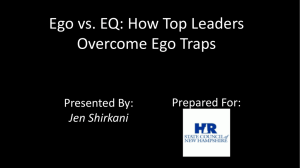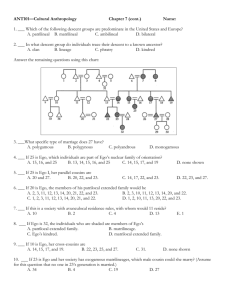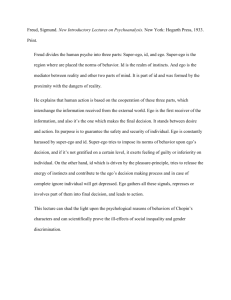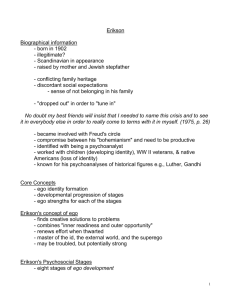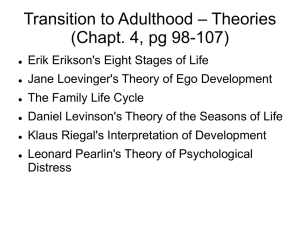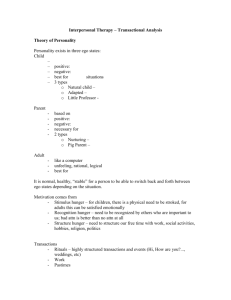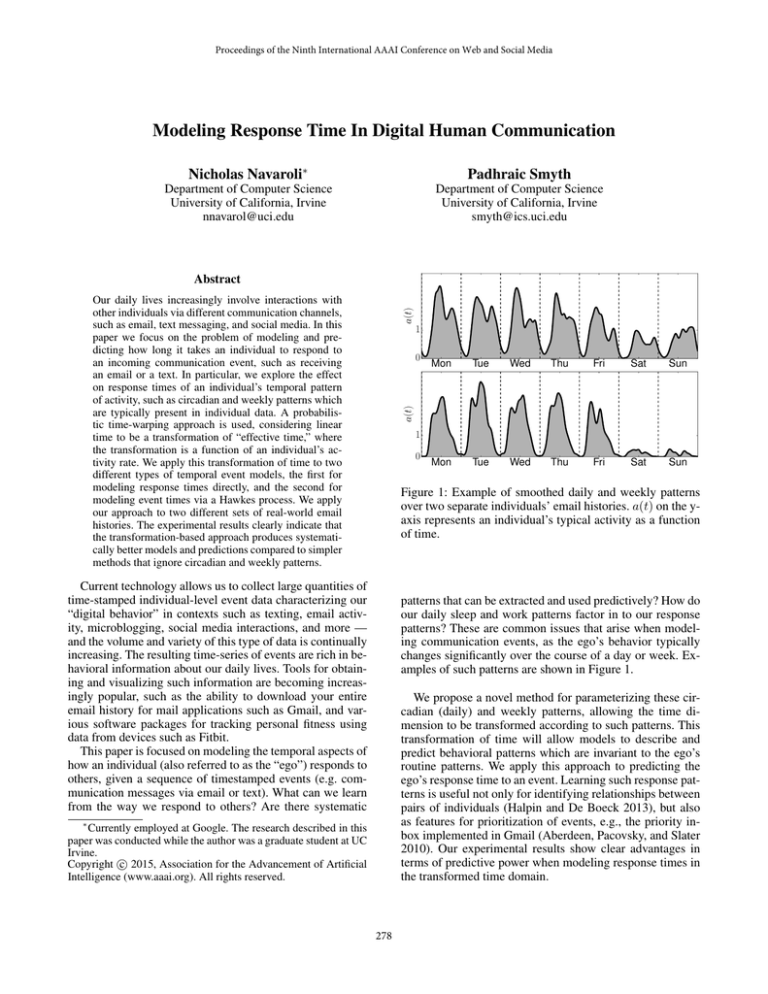
Proceedings of the Ninth International AAAI Conference on Web and Social Media
Modeling Response Time In Digital Human Communication
Nicholas Navaroli∗
Padhraic Smyth
Department of Computer Science
University of California, Irvine
nnavarol@uci.edu
Department of Computer Science
University of California, Irvine
smyth@ics.uci.edu
Abstract
a(t)
Our daily lives increasingly involve interactions with
other individuals via different communication channels,
such as email, text messaging, and social media. In this
paper we focus on the problem of modeling and predicting how long it takes an individual to respond to
an incoming communication event, such as receiving
an email or a text. In particular, we explore the effect
on response times of an individual’s temporal pattern
of activity, such as circadian and weekly patterns which
are typically present in individual data. A probabilistic time-warping approach is used, considering linear
time to be a transformation of “effective time,” where
the transformation is a function of an individual’s activity rate. We apply this transformation of time to two
different types of temporal event models, the first for
modeling response times directly, and the second for
modeling event times via a Hawkes process. We apply
our approach to two different sets of real-world email
histories. The experimental results clearly indicate that
the transformation-based approach produces systematically better models and predictions compared to simpler
methods that ignore circadian and weekly patterns.
1
Mon
Tue
Wed
Thu
Fri
Sat
Sun
Mon
Tue
Wed
Thu
Fri
Sat
Sun
a(t)
0
1
0
Figure 1: Example of smoothed daily and weekly patterns
over two separate individuals’ email histories. a(t) on the yaxis represents an individual’s typical activity as a function
of time.
Current technology allows us to collect large quantities of
time-stamped individual-level event data characterizing our
“digital behavior” in contexts such as texting, email activity, microblogging, social media interactions, and more —
and the volume and variety of this type of data is continually
increasing. The resulting time-series of events are rich in behavioral information about our daily lives. Tools for obtaining and visualizing such information are becoming increasingly popular, such as the ability to download your entire
email history for mail applications such as Gmail, and various software packages for tracking personal fitness using
data from devices such as Fitbit.
This paper is focused on modeling the temporal aspects of
how an individual (also referred to as the “ego”) responds to
others, given a sequence of timestamped events (e.g. communication messages via email or text). What can we learn
from the way we respond to others? Are there systematic
patterns that can be extracted and used predictively? How do
our daily sleep and work patterns factor in to our response
patterns? These are common issues that arise when modeling communication events, as the ego’s behavior typically
changes significantly over the course of a day or week. Examples of such patterns are shown in Figure 1.
We propose a novel method for parameterizing these circadian (daily) and weekly patterns, allowing the time dimension to be transformed according to such patterns. This
transformation of time will allow models to describe and
predict behavioral patterns which are invariant to the ego’s
routine patterns. We apply this approach to predicting the
ego’s response time to an event. Learning such response patterns is useful not only for identifying relationships between
pairs of individuals (Halpin and De Boeck 2013), but also
as features for prioritization of events, e.g., the priority inbox implemented in Gmail (Aberdeen, Pacovsky, and Slater
2010). Our experimental results show clear advantages in
terms of predictive power when modeling response times in
the transformed time domain.
∗
Currently employed at Google. The research described in this
paper was conducted while the author was a graduate student at UC
Irvine.
c 2015, Association for the Advancement of Artificial
Copyright Intelligence (www.aaai.org). All rights reserved.
278
∆2
∆0
Related Work
Incoming
Response
Initiating
When considering the time it takes for an individual to respond to an event, large variations are often seen — responses are known to be “bursty”, usually sent quickly
or after long periods of inactivity (Barabási 2005; Malmgren et al. 2009). To capture the large variance in response
times, models such as the exponential distribution has been
proposed (Mahmud, Chen, and Nichols 2013), along with
longer-tailed distributions such as the power-law (Eckmann,
Moses, and Sergi 2004; Barabási 2005) or lognormal (Stouffer, Malmgren, and Amaral 2006; Kaltenbrunner et al. 2008;
Zaman, Fox, and Bradlow 2014). While these long-tailed
distributional forms are able to model large variances in response times, they do not take into consideration the typical
circadian or weekly behavior of the individual.
A more complex model which can incorporate circadian
and weekly patterns is the non-homogeneous Poisson process, which models the rate at which responses occur (as
opposed to the time difference between the incoming event
and response). Periodic response patterns can be modeled by
assuming the response rate λ(t) is piecewise-constant and
decomposed into a product of terms based on differentlyscaled time intervals (e.g. daily, hourly). This decomposition
of the response rate has been proven successful in describing
circadian patterns of email communication (Malmgren et al.
2009), instant messaging (Pozdnoukhov and Walsh 2010),
and telephone calls (Scott 2000).
A related model of communication response rates is the
Hawkes process (Hawkes 1971), where the overall rate of a
response is the superposition of many independent response
rates, one for each event the ego receives. These “selfexciting” models have been effective in capturing the burstiness of communication behavior (Malmgren et al. 2008;
Simma and Jordan 2010), however they do not directly
model circadian patterns. Hawkes processes have also been
used in other contexts of communication behavior, such as
inferring latent relationships between individuals in social
networks (Blundell, Beck, and Heller 2012; Fox et al. 2013;
Zipkin et al. 2014) and modeling dyadic interactions (Halpin
and De Boeck 2013; Masuda et al. 2013).
Our proposed approach for modeling circadian rhythms
is most similar to the work of Jo et al. (2012), who investigated the rescaling of time via histograms to remove
circadian and weekly patterns in exploratory data analysis
of individual communication events. Our work is similarly
motivated but extends this earlier work in several significant respects. First, we use smooth non-parametric kernels
(rather than histograms) to model temporal patterns. Second, we demonstrate how the transformation of time can be
effectively embedded in different statistical models such as
the Hawkes process. Lastly, we quantify the improvements
gained by transforming time with a series of systematic prediction experiments on out-of-sample data.
∆1
τ0
t0
τ1
τ2
t2
t1
Time
Figure 2: Illustration of communication event data and response times. The x-axis represents a timeline of events for
an individual (e.g., for their email inbox).
Problem Definition and Notation
We define an event e ≡ {s, τ, m} to be an observable action
performed by an actor s ∈ {1, 2, · · · , S} with a timestamp
τ ∈ R+ denoting the time the event occurred, and metadata
m describing the event. As an example, consider a text message being sent at time τ ; the actor s would be the message
sender, and metadata could include the message’s content,
recipients, and GPS coordinates.
Here we consider communication events from an egocentric perspective, where all events involve a single individual
or ego. For example, the ego may be owner of the phone
receiving and sending text messages, or the owner of an
email inbox. We distinguish between two different types of
events in such data: incoming events directed towards the
ego, and response events where the ego takes some action in
response to an incoming event. The distinction between the
event types is assumed to be contained in the metadata.
In this paper, we consider communication datasets (e.g.
all emails in an inbox) where τ = {τi : 1 ≤ i ≤ N }
denotes the timestamps of all incoming events (e.g. emails
the ego receives) and t = {ti > τi : 1 ≤ i ≤ N } the
timestamps of all response events from the ego. An ego’s
response pattern can be considered to be a mixture of two
models; first, a binary model indicating whether the ego
responds or not, and second the amount of time the ego
takes to respond (conditioned on the fact that the ego responds). The problem of whether or not an ego will respond
has been well-studied (Dredze, Blitzer, and Pereira 2005;
Aberdeen, Pacovsky, and Slater 2010; Navaroli 2014). In
this paper we focus on the second problem, that of modeling
the time to respond given that a response occurs.
Let ∆i ≡ ti − τi represent the individual’s response
time to event i. In the event that multiple responses to the
same event occur (e.g. the ego sends follow-up replies to
an email), ∆i represents the response time of the first response. This paper focuses on probability distributions of the
form p(∆i |Θ), where Θ represents the model’s parameters.
Figure 2 illustrates what these different quantities may look
like. Note that some events are labeled as initiating events —
these events occur when the ego initiates a conversation (instead of replying). Although we will explore a model which
is able to describe initiating events, the focus of this paper is
on the timing of response events.
Temporal Patterns in Communication Data
In communication data, strong circadian and weekly patterns are commonly found in an individual’s behavior. For
example, in professional email communication, people are
279
Global Average
14.4
Ego’s Activity
Average ∆i (hours)
16.8
12.0
9.6
7.2
4.8
Actual Time
a(t)
1
2.4
0.0
12 AM
6 AM
12 PM
5 PM
6 PM
Time of Day Email i was Received
Figure 3: Average response time ∆i as a function of hourof-day, for a single individual’s email data.
11 PM
Time →
5 AM
11 AM
Figure 4: Effective response time (dark shaded region) for
an ego responding, at 9 AM, to an incoming event from 11
PM the previous night.
generally more active and likely to write an email during the
daytime and on weekdays (e.g. see Figure 1). These strong
daily and weekly patterns are present not only for email data,
but for many types of communication data, such as mobile
text messaging (Jo et al. 2012) and “re-tweets” in Twitter
(Zaman, Fox, and Bradlow 2014).
As a result, the ego’s response time ∆i to event i can fluctuate with the time of day or week. Suppose an incoming
event occurs at night while the ego is asleep. The response
time ∆i for that event is likely to be large as the individual
may not have a chance to be aware of the event (let alone
reply to it) until they are awake. In contrast, an event received in the beginning of the ego’s daily routine may be
responded to after a shorter amount of time. An example of
this phenomenon (for one particular individual) is illustrated
in Figure 3, where the average response time is clearly dependent on when the email was received.
The circadian rhythms which cause ∆i to fluctuate over
time are not accounted for when modeling ∆i using standard probability distributions. Thus, parameters inferred as
a function over {∆i } are likely to misrepresent the individual’s dynamic activity. Additionally, circadian rhythms are
known to contribute to the large variances and heavy tails in
the estimated distributions (Barabási 2005; Fox et al. 2013).
Being able to effectively remove such patterns (in distributions over response time) will both 1) allow the distribution
to change as a function of time of day and week, and 2) reduce the variance in the resulting distribution.
We approach this problem by using an inhomogeneous
model where the distribution over ∆i depends on and
changes with τi , the time of the received event. There are
many ways to accomplish this; for example, by using a conditional density model allowing the model parameters Θ to
be a function of time, or using separate models for different
time intervals (e.g. every x hours or days). While such approaches are potentially useful, both have their drawbacks.
The temporal dependence of parameters in the conditional
density approach may be quite non-linear and difficult to
capture, while the binning approach will result in partitioning the data across time intervals, which are likely to be
sparse. With this in mind, the temporal transformation approach we discuss in the following sections has the advantage of being straightforward to implement and, as will be
shown in the experimental section, very effective.
Modeling Effective Response Times
We address the problems described in the previous section
˜ i to event
by considering the ego’s effective response time ∆
˜
i. By placing a probability distribution p(∆i |Θ) over effec˜ i ) of
tive response time and defining ∆i to be a function f (∆
˜
∆i , the following distribution is induced over ∆i :
˜ i Θ ∂ f −1 (∆i )
q(∆i |τi , Θ) = p ∆
(1)
∂∆i
˜ i = f −1 (∆i ), and ∂ f −1 (∆i ) the Jacobian of the
where ∆
∂∆i
inverse transformation. In principle we could use any transformation here, but a natural choice is to transform with respect to the activity of the user so that time is dilated at times
of high activity and contracted at times of low activity (Jo et
˜ i)
al. 2012). Thus, we define the transformation ∆i = f (∆
such that
Z τi +∆i
−1
˜
∆i = f (∆i |τ ) ≡
a(u)du
(2)
τi
where τi is the incoming event’s timestamp, and a : R+ →
R+ a positive function, referred to as the activity function.
˜ i to ∆i is dependent on
Note that this transformation from ∆
τi . When a(u) = 1 for all u (i.e., a user’s activity is constant
˜ i = ∆i and q(∆i |τi , Θ) = p(∆i |Θ).
over time), ∆
The value of the activity function a(t) at any point in time
can be interpreted as a relative “rate of activity” for the individual. We illustrate this interpretation with an example in
Figure 4. Suppose an incoming event occurs at τi = 11 PM
and the ego responds to it at ti = 9 AM the following day.
The actual response time is ∆i = 10 hours (the light shaded
area). With a(t) defined as the solid curve in Figure 4, the efR
˜ i = 9 AM a(u)du ≈ 4 hours, much
fective response time ∆
11 PM
less than the actual response time. Thus, values of a(u) < 1
throughout this time interval suggests that the ego’s activity
is lowered (e.g. asleep during the night). Similarly, values
of a(u) > 1 represent times where the ego is more active
than average (e.g. throughout the ego’s work day). Figure 1
showed examples of what a(t) may look like over a week.
280
a(t)
stochastic process. We then describe how to estimate the activity function a(t) given historical response data.
Note that our overall approach can be viewed from two
equivalent perspectives: (1) a “transformed time” approach
where we first transform the time dimension with respect to
a(t), then use a simple distributional form (such as a log˜ i |Θ, and (2) a relatively complex model
normal) to model ∆
over actual response time q(∆i |τi , Θ) induced by the sim˜ i |Θ in the transformed time domain. For exampler model ∆
ple, while p(∆i |Θ) in Figure 5 is unimodal (e.g. lognormal),
q(∆i |τi , Θ) in actual time can be multimodal, allowing the
model to capture complex aspects of the ego’s behavior relative to the activity function a(t).
10 AM
4 PM
10 PM
4 AM
τi = 10 AM
10 AM
4 PM
p(∆i|Θ)
q(∆i|τi, Θ)
10 AM
4 PM
10 PM
4 AM
10 AM
4 PM
τi = 10 PM
p(∆i|Θ)
Direct Modeling of Response Times
q(∆i|τi, Θ)
10 AM
4 PM
10 PM
4 AM
Time of Response
10 AM
In this section, we show how to use the transformation of
time to directly model the ego’s response time ∆i to event i.
Under this model, ∆i is assumed to be generated from
q(∆i |τi , Θ) induced by the distribution over effective re˜ i |Θ). Any distribution can be used to model
sponse time p(∆
˜ i |Θ); common examples used for response times inp(∆
clude the exponential (Malmgren et al. 2008; Fox et al.
2013), Gamma (Halpin and De Boeck 2013), and lognormal (Stouffer, Malmgren, and Amaral 2006; Zaman, Fox,
and Bradlow 2014) distributions. The log-likelihood of all
response times {∆i } (assuming response times are conditionally independent given the model) is
4 PM
Figure 5: Example of a probability distribution q(∆i |τi , Θ)
˜ i.
induced by a distribution over effective response time ∆
Unlike p(∆i |Θ), the shape of q(∆i |τ, Θ) depends on τi .
As an example of what the transformed distribution
q(∆i |τi , Θ) defined by Equation 1 may look like, suppose
the distribution p is lognormal with a mean time to respond of 4 hours and variance 3 hours. Figure 5 shows what
q(∆i |τi , Θ) (dark solid curve) would look like, compared to
a lognormal distribution over actual response time p(∆i |Θ)
(light solid curve), for responding to events received at τi =
10 AM (middle plot) and τi = 10 PM (bottom plot).
In this example, we assume the activity function used to
transform time is defined by the top plot in Figure 5. The
lognormal density p(∆i |Θ) is invariant to τi , thus has the
same shape for both events. While this distribution may be
sensible for the event received at τi = 10 AM, it does not
accurately describe the individual’s behavior in responding
to the event received at τi = 10 PM. In this case, much of the
probability mass is “wasted” in the late hours of the evening,
where the individual’s activity is low.
In contrast, the shape of the distribution q(∆i |τi , Θ) in
Figure 5 significantly changes between the two events. For
the event received at τi = 10 PM, most of the probability mass is shifted away from the night and to the early
hours of the morning where the ego becomes active. For the
event received at τi = 10 AM, the increased activity function (indicating the ego is active) causes q(∆i |τi , Θ) to become more peaked than p(∆i |Θ), thus the event is likely to
be responded to more quickly. As these examples show, the
specification of the activity function a(t) allows the distribution q(∆i |τi , Θ) over response time to “warp” significantly
in shape as a function of τi , minimizing the effects of the
individual’s circadian and weekly rhythms.
In the following sections, we describe how to apply the
˜ i to two different models of retime transformation using ∆
sponse behavior. The first directly models the response time
∆i , while the second models the timestamp ti > τi as a
log p({∆i }|{τi }, Θ) =
N
X
i=1
log q(∆i |τi , Θ)
(3)
Using the form of q(∆i |τi , Θ) and the transformation us˜ i defined by Equations 1 and 2 respectively, the loging ∆
likelihood is equal to
N
X
i=1
˜ i |Θ) +
log p(∆
N
X
log a(τi + ∆i )
(4)
i=1
where the first term is the log-likelihood over effective re˜ i }, and the second term the sum of logsponse times {∆
activity rates over the timestamps of all the ego’s responses.
Note that, conditioned on the activity function a(t), the second term is constant. Thus, estimating the model parameters Θ can be done using traditional methods (e.g. maximum
˜ i }.
likelihood) over effective response times {∆
This decoupling of the log-likelihood in Equation 4 emphasizes the modularity of our time transformation ap˜ i |Θ) is modeled as an exproach. For example, suppose p(∆
ponential distribution, where λ is the exponential mean (in
units of days). Conditioned on a(t), a maximum-likelihood
PN ˜
estimate of λ can be obtained by computing N1 i=1 ∆
i , the
mean effective response time. Given any (potentially complex) distributional form p, the introduction of and conditioning on a(t) does not increase the complexity of parameter inference — the only added complexity to the model is
first estimating a(t), which is discussed later.
As a side note, the process of applying the time transformation to an exponential distribution of response time has a
281
The log-likelihood of response times according to the
Hawkes process is thus,
strong connection to survival modeling. In survival models,
the response time ∆i is modeled with a survival function
Z x
S(x) ≡ P (∆i > x) = Exp −
h(u)du
log p({ti }|{τi }, Θ) =
0
where h(u) is referred to as a hazard function (Aalen, Borgan, and Gjessing 2008). One possibility is to set h(u) =
λa(u) for λ > 0. Under this parameterization, probabilities
under the survival model become equivalent to an exponential distribution with parameter λ warped according to the
activity function. This can be shown using the cumulative
density function Q(∆i |τi , λ) of an exponential distribution
transformed according to Equation 1 (assuming the incoming event was received at time τi = 0):
N
X
i=1
log λ(ti ) −
Z
T
λ(u)du
(6)
0
where it is assumed that the observed dataset is over the time
interval [0, T ] (Daley and Vere-Jones 2003).
The log-likelihood contains a log function over summations of terms (with λ(t) defined by Equation 5), which
can make parameter inference intractable. If the response
structure (e.g. which incoming event the ego replies to) is
unknown, the log-likelihood must marginalize over the response rates corresponding to all incoming events (Halpin
and De Boeck 2013; Olson and Carley 2013). However,
when the response structure is known (as is the case for the
email datasets used in the experiments), the response rate
λ(t) reduces to
g(t|τi ) if the ego replied to event i
λ(t) =
λ0 (t)
if the ego initiated the event
q(∆i > x|τi = 0, λ) = 1 − Q(x|τi = 0, λ)
Z x
= Exp −λ
a(u)du = S(x)
0
The relationship between the two models is useful in that it
allows the activity function a(t) to further be interpreted as
a rate at which an event (e.g. a response) will occur. Additionally, it shows that the proposed model can be viewed as a
variant of survival modeling where alternative distributional
forms other an exponential can be used.
With this parameterization of λ(t), maximum-likelihood estimates of model parameters can be numerically calculated
efficiently (no closed form exists due to the integral term in
Equation 6). As discussed with the direct model of response
time, applying the time transformation approach (via activity function a(t)) to the Hawkes process does not increase
the complexity of parameter inference.
The modeling choice for λ0 (t) is independent of the modeling of response times, as it describes the rate at which the
ego initiates new events (e.g. the initiating events from Figure 2). As the activity function a(t) from the previous section can be interpreted as a relative activity rate of the ego,
an appropriate modeling choice is λ0 (t) ∝ a(t), learning the
proportionality factor via maximum-likelihood.
Stochastic Process Models of Response Times
To illustrate the modularity of the time transformation approach, we now show how to embed it within a stochastic
process model. Stochastic processes do not model response
times, but rather the timestamps at which the ego sends a
communication event (e.g. the timing of the response and
initiating events from Figure 2). Additionally, repeated responses to the same event could potentially be modeled —
for more details, see Navaroli (2014).
In this paper, we focus on Hawkes processes (Hawkes
1971), which have successfully been used to model email
communication patterns (Simma and Jordan 2010; Fox et al.
2013; Halpin and De Boeck 2013). In a Hawkes process, the
ego’s rate λ(t) of sending a message at time t is
X
λ(t) ≡ λ0 (t) +
g(t|τi )
(5)
Estimation of the Activity Function
In order to apply the time transformation approach to the
direct response time model and the Hawkes process, an estimate of a(t) is required. A kernel-based approach is used to
estimate a(t) nonparametrically, and can be applied in either
a batch or online setting. This allows for efficient updates to
the estimation of a(t) in the presence of new activity.
Given the historical set of times of responses t = {ti :
1 ≤ i ≤ N } by the ego to incoming events (note that ti ≡
τi + ∆i ), the activity function a(t) is estimated as
N
Z X
∆w (t, ti )2
a(t) ≡
wi exp −
(7)
W i=1
2h2
i:τi <t
where λ0 (t) is the rate at which the ego initiates events (e.g.
sending an email that is not a reply; the initiating events in
Figure 2) and g(t|τi ) are the triggering functions describing the rate at which the ego responds to event i. Typically,
g(t|τi ) = νp(∆i |Θ), where p(∆i |Θ) is defined as before
(e.g. exponential, Gamma) and ν is interpreted as the expected number of replies to a single event (Fox et al. 2013).
The Hawkes process is useful in that the ego’s response
rate is a function of {τi } — as incoming events are received,
the ego’s rate of reply increases. However, the triggering
function g(t|τi ) is a function of the actual response time ∆i
and is prone to the same problems caused by circadian and
weekly patterns when modeling p(∆i |Θ). We can instead
model the rate of a response using the transformed time domain, where g(t|τi ) = νq(∆i |τi , Θ) and q(∆i |τi , Θ) defined as in Equation 1.
where
• ∆w (ta , tb ) ∈ [0, 3.5] days is the minimum weekly time
difference between two timestamps ta and tb
• h > 0 is referred to as the bandwidth parameter
• wi > 0 is the weight or “influence” of ti
PN
• W = i=1 wi is the sum of weights
282
2008
2008
2008
2009
2009
2009
2010
2010
2010
2011
2011
2011
2012
2012
2012
2013
2013
2013
2014
2014
2014
M
T
W
T
F
Empirical
S
S
M
T
W
T
F
S
S
M
α=0
T
W
T
F
S
Half-life of 60 days
S
Figure 6: Example where exponential decay of weighting datapoints becomes necessary. Left: smoothed histogram counts over
number of emails sent throughout each week; a clear change in behavior occurs in mid-2012. Middle: estimated a(t) over time
with α = 0 (no decay). Right: estimated a(t) over time with α set such that datapoints lose half their influence after 60 days.
1
• Z ≡ 7(2πh2 )− 2 a normalization constant such that
R t+7
a(u)du = 7, ensuring that model parameters are on
t
the scale of days for interpretability
Experiments
Email Datasets
We evaluated our time transformation approach using two
different email corpora. The first is Gmail data from three
volunteers affiliated with our research group. The email
timestamps, anonymized email ids, and response structure
were downloaded from the email servers using a Python
script. The inbox activity for each individual spans several
years with thousands of responses, and is shown in Table 1.
The structure of this estimate is similar to weighted kernel
density estimation; the majority of activity “mass” in a(t)
is placed during previously-active times for the ego. Examples of estimated activity functions using Equation 7 for two
different egos were shown in Figure 1, using a bandwidth
parameter of h = 90 minutes. Clear circadian and weekly
patterns can be seen for both individuals.
When wi = 1 for all i, each historical timestamp is given
an equal weight in the estimation of a(t). This can cause
problems when a significant change in the ego’s behavior
occurs. For example, the ego represented in Figure 6 experiences a significant change in behavior (left plot) in the middle of 2012 — the ego moved from one country to another.
Not only did the timezone shift for the ego, but their nonwork days shifted from Friday/Saturday to Saturday/Sunday.
When wi = 1, the resulting estimate of a(t) averages the
patterns from both countries together, resulting in an activity
function that is not representative of the individual’s actual
behavior (middle plot of Figure 6).
This problem can be avoided by allowing the weights of
datapoints in the estimation of a(t) to decay over time. Here
we use exponential weighting:
wi ≡ exp − α(tN − ti )
Ego
Gmail A
Gmail B
Gmail C
First Email
Nov 2007
Nov 2007
Aug 2006
Last Email
Jul 2014
Jun 2014
May 2014
# Responses
4268
1613
23950
Table 1: Summary statistics of Gmail datasets.
Second, we use data from the publicly-available Enron
email corpus (Klimt and Yang 2004). Unlike the Gmail data,
the response structure was not available — the structure was
inferred based on recipient and normalized subject matching
(e.g. removing instances of “fwd” and “re”). Enron employees that sent 200 or more responses were used in these experiments. The number of responses and activity timespan
across the resulting 23 employees are shown in Figure 7.
Thus, in total we use email histories from 26 different individuals (3 Gmail, 23 Enron), varying significantly not only
in volume and timespan, but also in temporal behavior and
the number of email recipients responded to. A more thorough analysis of the datasets is provided in Navaroli (2014).
Each email dataset was independently analyzed in the following experiments (e.g. model parameters are not shared
across individuals)1 .
where α ≥ 0 is a decay parameter determining the “halflife” of weights, and tN the most recent time point. When
α = 0, wi = 1 for all k. By weighting the datapoints the estimated activity function is able to “forget” older events, allowing the estimate to adapt to behavioral changes. The right
plot in Figure 6 shows that, by setting α > 0, the change
in behavior due to the ego’s moving between countries is
quickly reflected in estimates of a(t) after the changepoint.
1
Python code available at http://www.datalab.uci.edu/resources
and tested using Python 2.7, Numpy 1.8.1, Scipy 0.14.0, and Matplotlib 1.3.1.
283
h (hours)
# Days
1000
800
600
400
0
200
400
3
2
1
0
0
600 800 1000 1200 1400
# Responses
50
100 150 200 250 300 350 400 450
α (half-life in days)
Figure 8: Estimated values of hyperparameters h and α, per
email dataset.
Figure 7: Summary statistics of Enron datasets.
Experimental Setup
weak — only the first few days of processed data are significantly affected by the prior. For parameters with nonconjugate priors (e.g. a Gamma prior over each parameter
in the Gamma distribution), maximum a posteriori estimates
are obtained numerically.
The hyperparameters h and α used to estimate a(t) are
derived from the 20% initial data. 10-fold cross-validation is
used to set h, maximizing the cumulative value of log a(t)
over validation points. The value of α is heuristically set
such that, on average:
For each email dataset, the following models are considered:
• Direct models of response times (e.g. Equation 3) using
exponential, Gamma, and lognormal distributions,
• Hawkes processes of response rates (e.g. Equation 6) using exponential, Gamma and lognormal triggering functions.
For each model, two separate variants are trained, each using
a different estimator of a(t):
1. Baseline: a(t) = 1, e.g. no transformation of time. This
variant does not take into account circadian rhythms when
estimating model parameters.
W =
N
X
i=1
2. Proposed model: a(t) is estimated nonparametrically
from historical data, allowing for normalization of response times according to circadian rhythms.
wi ≈ ñ(1 − exp(−α))−1 = 150
where ñ is the average number of emails the ego sends per
day, estimated from the initial data. Solving for α in the
above equation allows the sum of weights in the estimation of a(t) via Equation 7 at any point in time to be approximately 150 “effective” datapoints. In some cases, this
heuristic setting will cause the estimation to “forget” datapoints too rapidly — the minimum value of α considered
is one where the half-life a datapoint’s influence is 35 days
2
(e.g. α ≥ log
35 ). The resulting estimates of h and α for each
of the 26 email datasets are shown in Figure 8.
Lastly, the estimation of a(t) is regularized in order to
stabilize estimates in the presence of little data:
W
ρ
a(t) =
â(t) +
W +ρ
W +ρ
All models are trained and evaluated in an online setting
where new data is continually being observed. The first 20%
(chronologically) of each individual’s data is used for initialization, e.g., to estimate the hyperparameters h and α (described in the following section). For the remaining 80% of
the data, the model is iteratively trained on data up to and
including day d − 1 and then probabilities are computed for
the (test) response times observed from day d.
As each model moves forward in time, their parameters
are updated with each day’s worth of new data, resulting
in new estimates of model parameters and activity function
a(t). We use this sequential approach as it mimics closely
how models like this could be used with real event data;
similar experimental results were obtained when using more
traditional “batch” training/test datasets.
Model evaluation is done using the probability assigned
by the model to new data; more specifically the test loglikelihood which is the sum of log probability over test datapoints unseen by the model. The test log-likelihood is widely
used for evaluating the quality of probabilistic models (Murphy 2012), where models yielding higher test log-likelihood
are better in the sense that they assign higher probabilities to
future data that actually occurred.
where ρ ≥ 0 is a smoothing parameter (interpreted in units
of pseudo-datapoints), and â(t) is the estimation of a(t) via
Equation 7. For these experiments, we set ρ = 10 pseudodatapoints; the experimental results were largely unaffected
for values of 5 ≤ ρ ≤ 20.
Experimental Results: Log-Likelihood
Figures 9 and 10 compare the mean test log-likelihood between the proposed model where a(t) is estimated nonparametrically and the baseline model where a(t) = 1, for the
direct and Hawkes process models respectively. In each figure, a single email dataset is represented as three datapoints
— one for each of the exponential, Gamma, and lognormal
distributions. The x-axis represents the baseline modeling of
response time, and the y-axis represents the proposed modeling of response time.
Priors and Hyperparameters
Appropriate priors are placed over each model parameter
(e.g. a Gaussian prior over the lognormal mean, a Gamma
prior over the exponential mean), and are set to be relatively
284
2
−2.5
Figure 9: Test mean log-likelihood between direct models modeling q(∆i |τi , Θ) (y-axis) versus p(∆i |Θ) (x-axis).
Higher values indicate a better fit of the model.
−3.0
−1.5
−2.0
−3.0
−3.5
−3.5
3
−2.0
−1.5
1
0
Lognormal
−2.5
Exponential
−2 −1
−2 −1
1
−2.5
0
1
Gamma
−2.0
2
−1.5
Gamma
3
−1.0
Figure 11: Test mean log-likelihood between different distributional forms of q(∆i |τi , Θ). Top row: direct response
time models. Bottom row: Hawkes process models.
Exponential
Gamma
Lognormal
−3.0
−2.5
−2.0
−1.5
Without Transformation
a(t)
With Transformation
−1.0
−2.5
0
Lognormal
1
−1
Exponential
−1.0
−2
−1
0
Without Transformation
Gamma
−3
−2
−2.5 −2.0 −1.5 −1.0 −0.5
−3
−3
2
3
2
−2
−4
−4
1
−2 −1
−1
0
Gamma
0
Exponential
Gamma
Lognormal
−1.5
1
−2.0
With Transformation
2
−1.0
2.5
2.0
1.5
1.0
0.5
12 AM
Figure 10: Test mean log-likelihood between Hawkes process models modeling q(∆i |τi , Θ) (y-axis) versus p(∆i |Θ)
(x-axis). Higher values indicate a better fit of the model.
6 AM
12 PM
6 PM
12 AM
Figure 12: Example of a piecewise-constant estimate of a(t).
time models (Stouffer, Malmgren, and Amaral 2006), Figure
11 shows that similar results are obtained 1) for models over
transformed response time, and 2) for Hawkes processes.
In addition to the baseline, another model was applied
where the activity function a(t) is estimated as a histogram
(piecewise-constant) using one-hour time intervals and a periodicity of 24 hours. An example of such an estimate is
shown in Figure 12. Note that this parameterization allows
the direct response time model using an exponential distribution to be equivalent to a non-homogeneous Poisson process
with piecewise-constant response rate, similar to Malmgren
et al. (2009). In general, the log-likelihood of this intermediate model was in-between the baseline and proposed models. Results are omitted due to space, but can be found in
Navaroli (2014).
A systematic increase in log-likelihood is seen across all
datasets and distributional forms when using the proposed
model of response times, compared to the baseline model.
These results are significant on a 99% confidence interval,
using a Wilcoxon signed test. This improvement results from
the ability of the proposed model to rescale time, taking into
account the typical temporal patterns of each individual. For
example, the largest gain from transforming time in eventwise log-likelihood occurs during the morning hours (not
shown), where the ego is presumably responding to emails
from the previous night; this is precisely the type of scenario
portrayed in the bottom plot in Figure 5.
In Figure 11, the log-likelihood of the different distributional forms of q(∆i |τi , Θ) are compared (similar patterns
were found for p(∆i |Θ)), for both direct models of response
time (top row) and Hawkes processes (bottom row). Across
all email datasets, the log-likelihood using the Gamma distribution is higher than the exponential distribution, with the
highest log-likelihood achieved using the lognormal distribution. While this has previously been shown for constant-
Experimental Results: Prediction of Response
Within a Time Interval
In our second set of experiments, we explore the proposed
model’s power in terms of predicting whether or not an incoming event will be responded to within a certain interval
285
of time (e.g. 2 hours), compared to the baseline model of the
previous section. Conditioned on the ego responding to an
incoming event, the task is to predict whether that event will
be responded to sooner instead of later, e.g. for the task of
email prioritization (Aberdeen, Pacovsky, and Slater 2010).
Let Q(∆i |τi , Θ) be the cumulative density function of
q(∆i |τi , Θ). For a given time window , the probability that
an event received at time τi will be responded to within time is
• pτi = Q(∆i = |τi , Θ) for direct response time models,
• pτi = 1 − exp(−Q(∆i = |τi , Θ)) for Hawkes process
models (Daley and Vere-Jones 2003).
After calculating pτi for each incoming event i in the sequential manner described earlier (for each individual and
model), the set of resulting probabilities {pτi } are sorted and
an area-under-the-curve (AUC) metric is computed relative
to ground truth (i.e. whether or not the event was replied to
within time). Larger AUC values indicate that the model
is able to better distinguish which incoming events will be
responded to within time. Here results for = 2 hours are
reported — similar results were obtained for other windows
of time ranging from 1 to 8 hours.
Figures 13 and 14 compare the AUC between the proposed model where a(t) is estimated nonparametrically and
the baseline model where a(t) = 1, for the direct and
Hawkes process models respectively. Modeling response
times using the proposed model results in a significant increase in AUC across the 26 email datasets. This is due to the
ability of the proposed model to 1) adapt the predictions pτi
to the daily and weekly effects parameterized by a(t), and 2)
predict that the probability of the ego quickly responding is
high (low) when their activity during the time of the received
event is high (low) (e.g. see Figure 15).
We also compared to the performance of the intermediate model (where a(t) is estimated using a histogram, e.g.
Figure 12), however the results are not shown here. Similar to the log-likelihood results, the AUC of the intermediate model was generally higher than the baseline model, but
lower than the proposed model.
With Transformation
0.9
0.8
0.7
Exponential
Gamma
Lognormal
0.6
0.5
0.4
0.2
0.3
0.4
0.5
0.6
Without Transformation
0.7
0.8
Figure 13: AUC between direct models modeling
q(∆i |τi , Θ) (y-axis) versus p(∆i |Θ) (x-axis). Higher
values indicate more accurate predictions.
With Transformation
0.9
0.8
0.7
Exponential
Gamma
Lognormal
0.6
0.5
0.4
0.2
0.3
0.4
0.5
0.6
Without Transformation
0.7
0.8
Figure 14: AUC between Hawkes process models modeling
q(∆i |τi , Θ) (y-axis) versus p(∆i |Θ) (x-axis). Higher values
indicate more accurate predictions.
Conclusions
In this paper we addressed the problem of modeling the time
it takes an individual to respond to incoming communication events. Understanding such response patterns is important in terms of both improving our general understanding
of human communication patterns and for designing better
tools to assist us in managing our increasingly rich and complex communication channels (e.g., via automated prioritization). The primary novel contribution of our work is the
explicit modeling of the effective time it takes an ego to respond based on their typical daily and weekly patterns (as
determined by the activity function a(t)). We showed the
flexibility of the proposed technique by applying it to two
different approaches for modeling response times.
Experimental results across 26 different email histories
showed a noticeable improvement in predictive performance
when introducing the activity function a(t) into both direct
and stochastic process models of response times, suggesting
Probability
0.8
0.6
0.4
Empirical
Proposed
Baseline
0.2
12 AM
6 AM
12 PM
6 PM
12 AM
Figure 15: Probability of, for one individual, responding to
an email within = 2 hours according to 1) the empirical
data, 2) the proposed model, and 3) the baseline model.
286
Kaltenbrunner, A.; Gómez, V.; Moghnieh, A.; Meza, R.;
Blat, J.; and López, V. 2008. Homogeneous temporal activity patterns in a large online communication space. IADIS
International Journal on WWW/INTERNET 6(1):61–76.
Klimt, B., and Yang, Y. 2004. The Enron corpus: a new
dataset for email classification research. In Proceedings of
the European Conference on Machine Learning, 217–226.
Springer.
Mahmud, J.; Chen, J.; and Nichols, J. 2013. When will
you answer this? Estimating response time in Twitter. In
Proceedings of the Seventh International Conference on Weblogs and Social Media. AAAI Press.
Malmgren, R.; Stouffer, D.; Motter, A.; and Amaral, L.
2008. A Poissonian explanation for heavy tails in e-mail
communication. Proceedings of the National Academy of
Sciences of the United States of America 105(47):18153–
18158.
Malmgren, R.; Hofman, J.; Amaral, L.; and Watts, D. 2009.
Characterizing individual communication patterns. In Proceedings of the 15th ACM SIGKDD International Conference on Knowledge Discovery and Data Mining, 607–616.
ACM.
Masuda, N.; Takaguchi, T.; Sato, N.; and Yano, K. 2013.
Self-exciting point process modeling of conversation event
sequences. In Temporal Networks, Understanding Complex
Systems. Springer Berlin Heidelberg. 245–264.
Murphy, K. 2012. Machine Learning: A Probabilistic Perspective. MIT Press.
Navaroli, N. 2014. Generative Probabilistic Models for
Analysis of Communication Event Data with Applications
to Email Behavior. Ph.D. Dissertation, University of California, Irvine.
Olson, J., and Carley, K. 2013. Exact and approximate EM
estimation of mutually exciting Hawkes processes. Statistical Inference for Stochastic Processes 16(1):63–80.
Pozdnoukhov, A., and Walsh, F. 2010. Exploratory novelty
identification in human activity data streams. In Proceedings of the ACM SIGSPATIAL International Workshop on
GeoStreaming, 59–62. ACM.
Scott, S. 2000. Detecting network intrusion using a Markov
modulated nonhomogeneous Poisson process. Journal of the
American Statistical Association. Submitted.
Simma, A., and Jordan, M. 2010. Modeling events with
cascades of Poisson processes. In Proceedings of the 26th
Conference on Uncertainty in Artificial Intelligence, 546–
555. AUAI Press.
Stouffer, D.; Malmgren, R.; and Amaral, L. 2006. Lognormal statistics in e-mail communication patterns. arXiv
preprint physics/0605027.
Zaman, T.; Fox, E.; and Bradlow, E. 2014. A Bayesian
approach for predicting the popularity of tweets. Annals of
Applied Statistics 8(3):1583–1611.
Zipkin, J.; Schoenberg, F.; Coronges, K.; and Bertozzi, A.
2014. Point-process models of social network interactions:
parameter estimation and missing data recovery. European
Journal of Applied Mathematics. Submitted.
that the models were able to adapt to the strong circadian
and weekly patterns experienced by the ego. A potential direction of further study would be to incorporate additional
information into the distribution over response time — for
example, how long the ego takes to respond may depend on
who sent the incoming event. However, we found in preliminary experiments (not shown) that including such information did not improve predictions; this is likely to be due to
data sparsity at the individual sender level.
While here we only explored the time transformation approach for direct and Hawkes process models, the approach
is both modular and general and can be straightforwardly applied to other event response models, such as different forms
of Poisson rate models.
Acknowledgments
This work was supported in part by an NDSEG fellowship
for NN, a Google faculty award for PS, and NSF award IIS1320527. Additionally, the authors thank Moshe Lichman
for his participation in discussions and his helpful comments
and suggestions.
References
Aalen, O.; Borgan, O.; and Gjessing, H. 2008. Survival and
Event History Analysis: A Process Point of View. Springer.
Aberdeen, D.; Pacovsky, O.; and Slater, A. 2010. The learning behind Gmail priority inbox. In NIPS 2010 Workshop on
Learning on Cores, Clusters and Clouds.
Barabási, A. 2005. The origin of bursts and heavy tails in
human dynamics. Nature 435(7039):207–211.
Blundell, C.; Beck, J.; and Heller, K. 2012. Modelling reciprocating relationships with Hawkes processes. In Advances
in Neural Information Processing Systems 25. Curran Associates, Inc. 2600–2608.
Daley, D., and Vere-Jones, D. 2003. An Introduction to the
Theory of Point Processes. Vol. I. Springer-Verlag.
Dredze, M.; Blitzer, J.; and Pereira, F. 2005. Reply expectation prediction for email management. In 2nd Conference
on Email and Anti-Spam.
Eckmann, J.; Moses, E.; and Sergi, D. 2004. Entropy of
dialogues creates coherent structures in e-mail traffic. Proceedings of the National Academy of Sciences of the United
States of America 101(40):14333–14337.
Fox, E.; Short, M.; Schoenberg, F.; Coronges, K.; and
Bertozzi, A. 2013. Modeling e-mail networks and inferring
leadership using self-exciting point processes. Preprint.
Halpin, P., and De Boeck, P. 2013. Modelling dyadic interaction with Hawkes processes. Psychometrika 78(4):793–
814.
Hawkes, A. 1971. Spectra of some self-exciting and mutually exciting point processes. Biometrika 58(1):83–90.
Jo, H.; Karsai, M.; Kertész, J.; and Kaski, K. 2012. Circadian pattern and burstiness in mobile phone communication.
New Journal of Physics 14(1):13055–13071.
287

